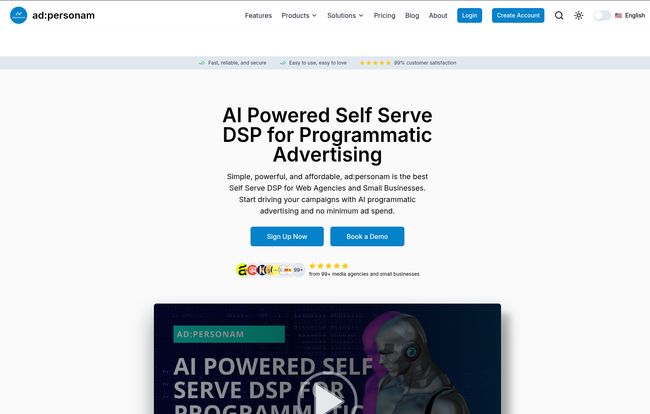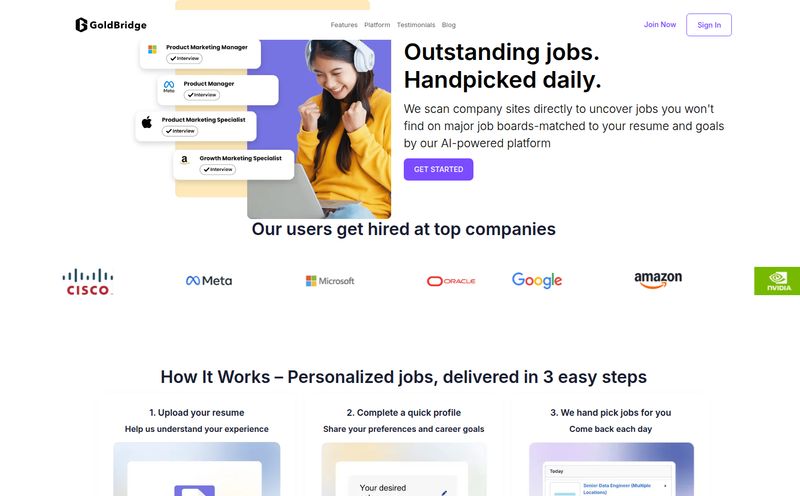Let’s have a little chat. For years, the world of programmatic advertising has felt like an exclusive, members-only club. You know the one. It has a velvet rope, a burly bouncer named 'Minimum Spend,' and a secret handshake that involves six-figure budgets. For the average small business owner, the startup founder, or the scrappy agency trying to deliver results, getting a seat at that table was next to impossible.
I’ve been in the trenches of SEO and CPC for more years than I care to admit, and I’ve seen this story play out a hundred times. Amazing brands with great products just couldn't get access to the powerful tools of programmatic buying. They were stuck wrestling with the ever-changing social media algorithms, praying for a win. It was frustrating.
So, when I started hearing whispers about a platform called ad:personam, my built-in skepticism kicked in. A self-serve Demand Side Platform (DSP) with AI-driven insights and... get this... no minimum ad spend? Yeah, right. I’ve heard that song before. But the buzz kept getting louder, so I decided it was time to pop the hood and see if the engine matched the shiny paint job.
So, What on Earth is ad:personam Anyway?
Before we go further, let's demystify the jargon. A DSP, or Demand Side Platform, is basically a stock market for digital ad space. It’s a tool that lets advertisers bid on and buy ad impressions across a bazillion websites, apps, and even Connected TVs, all in real-time. Powerful stuff. But traditionally, also incredibly complex and expensive.
Ad:personam enters the scene as a self-serve DSP. The key word here is “self-serve.” It’s designed to be used by you, the marketer, without needing a whole team of PhDs to operate it. It’s built on the back of Microsoft’s Invest DSP technology (formerly Xandr), which is a pretty solid foundation. It tells me they’re not just some fly-by-night operation; they're building on serious, enterprise-grade infrastructure.
The whole point is to give people like us—the ones without bottomless pockets—the keys to the programmatic kingdom. You can run video, CTV, mobile, and display campaigns, all from one spot.

Visit ad:personam
The Features That Genuinely Caught My Eye
Any platform can throw a list of features on a landing page. What I care about is what actually moves the needle. After poking around, a few things stood out.
The AI Assistant Planner: Your New Campaign Co-Pilot
Okay, I’ll admit it. My eyes glaze over when I see “AI-Powered” for the thousandth time. It's often just marketing fluff. But ad:personam’s AI Assistant Planner seems... practical. The idea is that you feed it your goals, budget, and target audience, and it helps you build a smart, multi-channel campaign plan. For someone new to programmatic, this is huge. It’s like having a seasoned media planner looking over your shoulder, preventing you from making rookie mistakes. It helps you navigate the sheer number of options without getting analysis paralysis. This is also the core of their free plan, which is a clever way to let people see the value firsthand.
No Minimum Spend. I'll Say It Again. No Minimum Spend.
This is the big one. This is the showstopper. I remember a time when you couldn’t get a call back from a DSP rep unless you were promising at least a $20k or $50k monthly commitment. It created a massive barrier to entry. Ad:personam throws that whole model out the window. This single point democratizes programmatic advertising more than any other feature. It means you can finally experiment. You can run a small, targeted test campaign for a few hundred bucks to see what works. For a small business, that ability to test and learn without betting the farm is everything.
Getting Your Ads Seen: Smarter Inventory and Targeting
A campaign is only as good as where its ads are shown and who sees them. Ad:personam talks about giving access to premium inventory and curated deals. In plain English, this means your ads aren't just relegated to the dusty corners of the internet. You get a shot at placing them on high-quality sites and apps where your actual customers hang out.
Even more interesting is the focus on cookieless targeting options. With the whole 'cookiepocalypse' upon us and Google finally phasing out third-party cookies, any platform not prepared for this new reality is already a dinosaur. Seeing ad:personam actively provide solutions for a cookieless world (like contextual and first-party data targeting) is a massive green flag. It shows they’re looking at the future of digital advertising, not just the present.
Let's Talk Turkey: The Pricing Structure
Alright, so how much is this going to set you back? Their pricing is refreshingly straightforward, which is another thing I appreciate in an industry that often hides costs behind jargon. Here’s a quick breakdown I put together:
| Plan | Price per Month | Best For |
|---|---|---|
| Free | €0 | Dipping your toes in. You get access to the AI Assistant Planner to map out campaigns and see what's possible. No risk. |
| Starter | €149 | Small businesses, startups, and solo marketers ready to launch their first real programmatic campaigns. This gives you full DSP access. |
| Pro | €299 | Growing businesses and small agencies that need more advanced tools, support for more ad formats, and priority support. |
To me, the Starter plan at €149 is the sweet spot. It unlocks the full power of the self-serve platform for less than what you might spend on a fancy dinner. It's a low-risk investment to access some seriously powerful advertising technology.
The Good, The Bad, and The Realistic
No tool is perfect. Let’s be real. Here’s my honest breakdown.
What I Genuinely Liked
The transparency is a breath of fresh air. From the pricing to the features, it doesn't feel like they're trying to pull a fast one. The interface is clean and seems designed for humans, not robots. But the biggest win, and I'll keep saying it, is the removal of the minimum spend barrier. It fundamentally changes who can and should be using programmatic advertising.
A Few Things to Keep in Mind
It's not all sunshine and rainbows. The platform is powerful, but true mastery of programmatic still has a learning curve. Don't expect to be a media-buying wizard overnight. Also, for the real power-users and big agencies, there are some limitations. For full API integration with the underlying Xandr Invest DSP, you'd need your own DSP seat, which is a whole different ballgame. And naturally, some of the most advanced, granular features are reserved for the higher-tier Pro plan. The free plan is great, but it’s a planner, not an execution tool—you have to upgrade to actually launch anything.
So, Who Is This Tool Really For?
After spending some time with it, I have a pretty clear picture of the ideal ad:personam user.
- The Scrappy Startup Founder: You're wearing ten hats, and one of them is 'marketer.' You've hit a ceiling with social ads and need a new channel to drive growth without a massive upfront cost.
- The Small-to-Medium Business Owner: You have a steady business and a modest marketing budget. You want to try more sophisticated advertising like CTV or display retargeting but were always priced out.
- The Nimble Digital Agency: You want to offer programmatic services to your clients but don't have the resources or client budgets to justify a contract with a major DSP. This lets you add a powerful new tool to your arsenal.
If you're an ecommerce store that's killing it on Instagram but wants to reach people watching streaming services, this is your entry point. If you're a B2B service that wants to target specific professionals on industry websites, this is a way to do it efficiently.
Frequently Asked Questions about ad:personam
I've seen a few questions pop up, so let's tackle them head-on.
- 1. I'm new to this. What even is a Self-Serve DSP?
- Think of it as your personal control panel for buying ads across the internet. Instead of going through a sales rep, you log in, set up your campaigns, choose your audience, and manage your budget directly. It gives you all the control.
- 2. Seriously, is there a minimum ad spend?
- Nope. The platform itself has a monthly subscription fee (for paid plans), but you are not required to spend a minimum amount on the ads themselves. You can run a campaign with a budget of €100 or €10,000.
- 3. Who is this designed for? Just big companies?
- Quite the opposite, actually. While anyone can use it, it's specifically designed to be accessible for small businesses, startups, and agencies who have historically been shut out of programmatic advertising due to high costs and complexity.
- 4. What kind of websites and apps can my ads run on?
- You get access to a wide range of inventory, including major publishers, niche blogs, mobile apps, and even Connected TV (CTV) platforms. The platform's connection to the Microsoft Ad Exchange opens up a huge network of possibilities.
- 5. How does the cookieless targeting work?
- It shifts the focus from tracking individual users with cookies to other signals. This includes contextual targeting (placing ads on pages with relevant content), using first-party data (your own customer data), and leveraging other privacy-safe identifiers. It's the new standard for a more privacy-conscious web.
My Final Verdict: Is ad:personam Worth It?
So, we come back to the original question. Is ad:personam the real deal? In my opinion, yes. It's a genuinely solid step in the right direction for the industry.
It's not a magic button that will instantly triple your revenue. Let's manage expectations. Programmatic advertising still requires thought, strategy, and good creative. But what ad:personam does, and does well, is remove the ridiculous barriers that have kept so many smart marketers on the sidelines. It replaces the intimidating, expensive gatekeeper with an affordable, user-friendly welcome mat.
For the first time, a truly powerful advertising channel is within reach for almost everyone. And I think that's pretty exciting. If you've ever been curious about programmatic but were scared off by the price tag, I'd say give their free AI planner a spin. You have absolutely nothing to lose and a whole new world of traffic to potentially gain.



